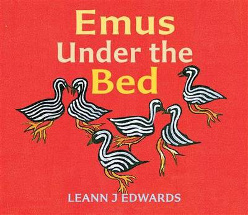Emus under the bed by Leann J Edwards

The Little Big Book Club/ Allen & Unwin 2014. ISBN
9781743313459.
(Age: Early childhood) On Saturdays I visit Auntie Dollo. 'What
would you like to do today?' she says. 'Do you want to help me make
some feather flowers?' Auntie Dollo has all kinds of feathers.
She has feathers from moorhens, magpies, galahs and
cockatoos. But the greatest surprise is what is under
Aunty Dollo's bed - six little emu chicks!
This is a vibrant story which shows how a modern Indigenous child
continues to connect with the traditions of the past through her
family. The relationship between the environment and the
people is very clear as they make a headdress of feathers dropped by
local birds, and as they create it, Aunt Dollo tells the story of
its origins. Written by a descendant of the Mara tribe from
the Gulf of Carpentaria and the Wiradjuri tribe from central New
South Wales, it celebrates the handing down of an ancient culture
through its people and ensuring 'They are the pool of inspiration
all the time.' Having tried various ways of expressing her family
history and culture, particularly through a career as an Indigenous
artist, Leann Edwards was inspired by others to write and tell her
story and this book was produced through the Emerging Indigenous
Picture Book Mentoring Project, a joint initiative between The
Little Big Book Club and Allen & Unwin, assisted by the
Australian Government through the Australia Council, its arts
funding and advisory body. The artwork is most striking and
has many of the elements we associate with Indigenous art, and shows
the artist's experience both in Australia and overseas, with colour
and pattern predominating against blocks of solid colour.
Most importantly, this book ticks all the selection criteria for
acquiring and using Indigenous literature that Lorraine MacDonald
identifies in A Literature Companion for Teachers (p122-123).
There has been a number of books produced recently which feature our
first peoples celebrating their landscape, culture and heritage in
the most exquisite ways. How wonderful if we could use these
as models for our non-Indigenous students to tell their own stories
so they could leave a similar legacy.
Barbara Braxton